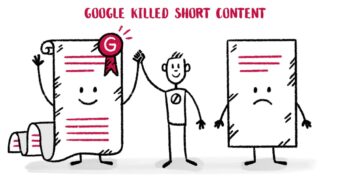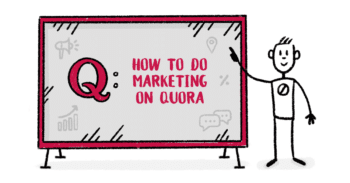How to Write the Perfect Content Brief for your SaaS Blog [With Examples + Template]
![How to write the perfect Content Brief for SaaS blogs [with templates & examples]](https://divbyzero.com/wp-content/uploads/2022/06/how-to-content-brief-1108x580.jpg)
You know it’s time to add a content brief in your workflow when the reputable freelance writer you just hired has once again missed the mark in their post.
The brief lays the foundation for every content, be it a blog post, ebook, or white paper. This editorial document also promotes consistency across different writers and ensures that you start on your best foot.
In this guide, you’ll learn how to create an effective content brief that sets your writers up for success, while reducing some painful editing from your end.
What is a Content Brief?
A content brief is a one to two-paged editorial document that details what needs to be covered in a piece of content to meet a business’s goals (e.g., ranking on Google, generating leads, attracting sales).
Content briefs are useful when outsourcing and writing in-house.
If you’re an in-house content strategist, you’ve probably hired freelance writers for your ultimate guides and how-to blog posts. The content brief provides relevant information without requiring writers to contact you directly.
Content briefs are also useful for posts you don’t normally assign to freelance writers (e.g., internal content like product updates and company announcements). These handy documents help in-house writers organize ideas, gain clarity, and ensure that they’re on the right track.
How do Content Briefs Improve Your Content Marketing Efforts?
Content briefs lay a solid foundation for all types of content. Add them to your workflow to maintain consistency and help your writers do their best work.
1. Guarantee consistency
According to SEMrush, 27.35% of marketers agree that the lack of consistency among their different freelance writers is the toughest aspect of outsourcing content.
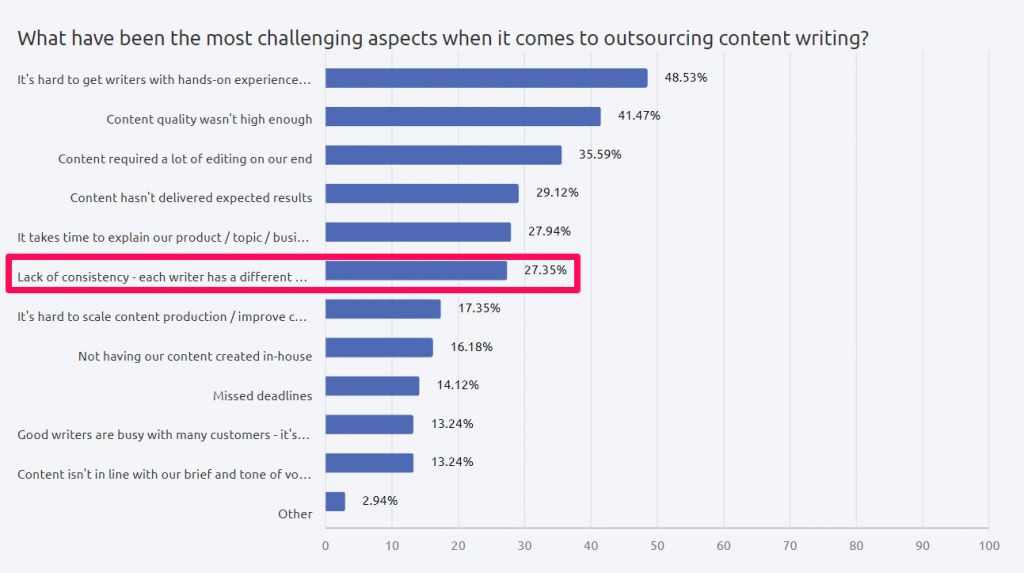
Each writer has a unique writing style.
While it’s impossible to “train” these writers to write the exact way, you can ensure consistency in your messaging across these different pieces of content.
The answer—you guessed it—lies in the brief.
2. Onboard freelance writers for success
Assigning a keyword without providing any context is very much like playing darts in the dark, especially when you’re working with a new writer.
It’s only a matter of time before the lack of information leads to poor results and a huge waste of effort.
With a content brief, content writers have everything they need at their fingertips to write effectively. In other words, it prevents the endless back-and-forth of emails.
3. Educate about product and industry
It’s rare for newly hired writers to grasp your industry, product, and the nuances of how it stacks up against competitors immediately on Day One.
These content writers juggle writing for different products across different niches. No wonder they’re not always in tune with the daily lives of prospective customers!
Fortunately, a detailed content brief can speed up the learning process.
By laying out the problem, solution, and how your product fills in the gap, new writers can get up to speed about your industry quickly.
How to Write a Content Brief? (with Real Content Brief Examples)
The success of a content brief lies in its details. As you create your brief, ensure that it provides sufficient information about the scope of the content, competing posts, and your target audience.
1. Headline
The headline is the first thing that hooks your readers—it tells them what your content is about at a glance.
It’s completely up to you if you want to craft the headline yourself or delegate it to your writer.
AppSumo, a digital marketplace for entrepreneurs, instructs its freelance writers to list five headlines when they submit their first draft. The startup then picks the best fit in the final editing.

Our recommendation: Include a working title to illustrate what you have in mind and encourage writers to share their recommendations in the draft. Pick the headline that has the highest chance of capturing interest.
2. Target audience
Your target reader represents your prospective customer.
For example, if you sell a marketing reporting tool, your target audience might be a marketing manager struggling to track data across different marketing channels.
Add a URL link to your buyer persona or ideal customer profile (ICP) to provide more context. Note how Breadcrumbs, a co-dynamic revenue acceleration platform, shares its ICP with freelance writers via Notion.
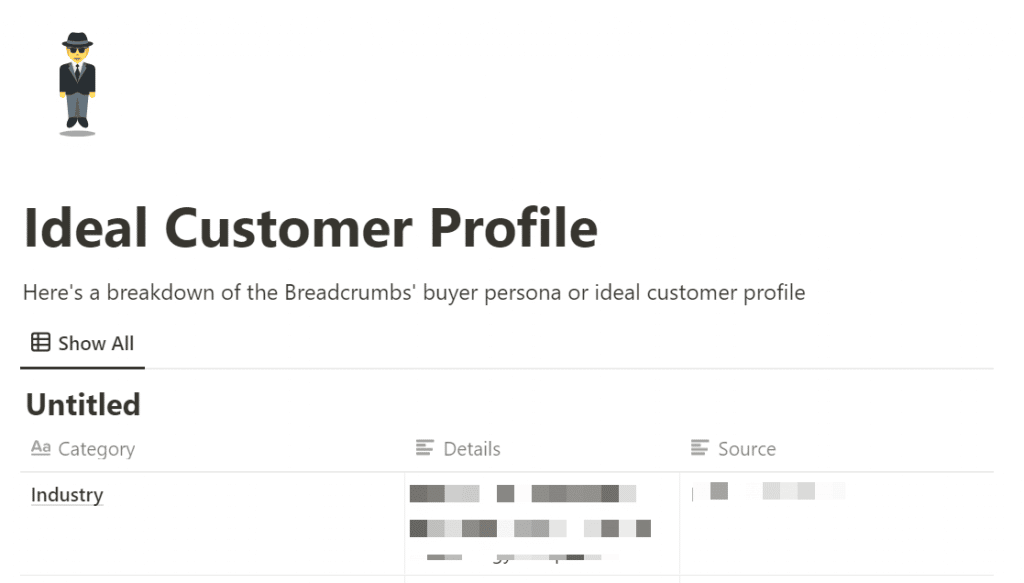
The target audience field helps freelance writers to put themselves in your ideal customers’ shoes and write content that speaks to their desires and struggles.
3. Search intent
The search intent is the goal behind a user’s search. Get it wrong, and your post will go down the drain before you even start.
Be as specific as possible when sharing the search intent for your target keyword(s). Ambiguity is a recipe for misaligned content!
Consider the two descriptions below for the keyword “content optimization”:
Version A: “Wants to learn about content optimization.”
Version B: “Wants to learn a step-by-step process of content optimization for SEO, conversions, and social shares.”
Version A states the obvious and raises questions (“Does the searcher want to learn about strategies, tips, or a step-by-step guide?”).
Whereas version B offers a specific “why” behind the search query. Right away, writers know what the post should focus on.
4. Overview
The overview element explains what you want your post to talk about.
Keep it short and punchy.
For example, if you were to target the keyword “Traffic Think Tank review,” you might write an overview like this:
“You’ve heard about Traffic Think Tank, the popular (and private) SEO training and community, but you want to learn more about it before taking the plunge. Is it worth spending $1190 a year? What’s the difference between The Full Accelerator and Self-Guided Learning? And is it really the best SEO community?”
5. Key takeaways
Key takeaways, also known as key insights, communicate what you want readers to walk away with after reading your post.
For example, a time card app might focus on these key takeaways in a comparison post to drive its message home that its app is an irreplaceable solution in the market today:
- [Our product] is the only time card app in the market that offers multi-app support
- [Our product] provides customized and seamless onboarding, a rare feature among competing tools
The key takeaways should differentiate your content from competing posts.
6. Keywords
This section is self-explanatory, as no blog post is complete without SEO keywords.
Include both the primary and secondary keywords in this field (note: keyword difficulty and volume are optional).
If you’re using a content optimization tool like Clearscope, share the report URL and your desired content rating with your freelance writers.
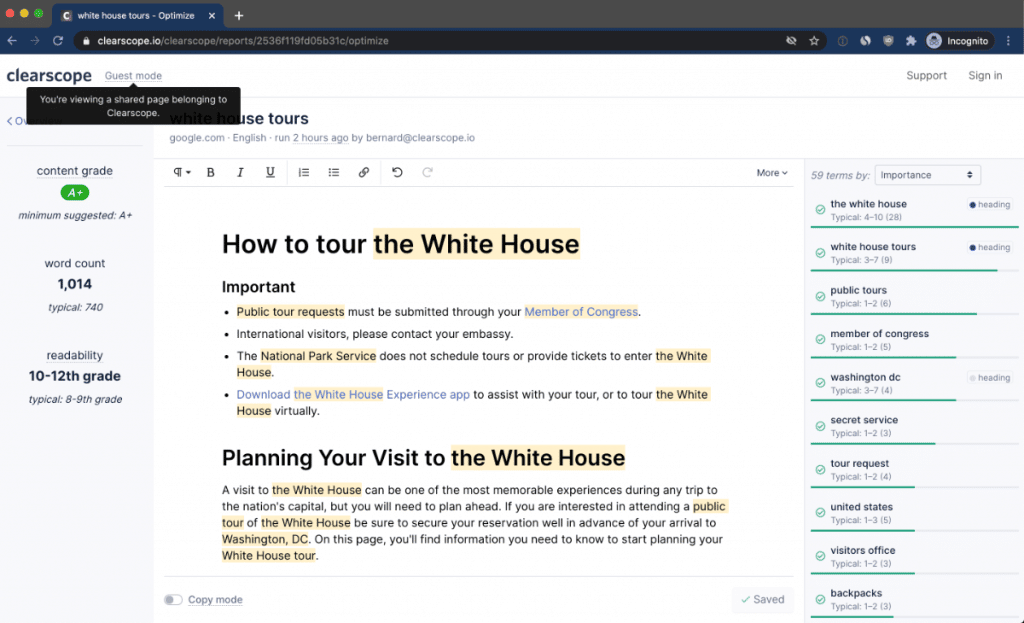
Source: Clearscope
This way, they can view the keyword density and optimize the content directly without needing to log in.
7. Word count
The word count field is the most straightforward in the content brief.
Include a ballpark figure of your ideal length. This helps writers estimate the amount of time required (and rate) to complete the project.
8. Success criteria
The success criteria, also known as goals or expected ROI, states what needs to happen for the content to be a success.
Common examples include:
- Ranking on page 1 of the SERPs
- Generating monthly leads
- Boosting direct sales
- Increasing organic blog traffic
Don’t skip this.
Having a success criteria in the content brief sets the right expectations from the get go and pushes the entire content team to achieve your target.
9. Deadline
Deadlines hold writers accountable.
Tip: Add all stakeholders, including your freelance writers, in a project management tool with dates for editing and publication to stay on track.
10. Notes
And finally, the notes field. This is the place to share valuable resources that turn a good content into a really great one.
Here are six types of resources you can’t go wrong with:
(i) Internal articles
Specify what related posts you want writers to link to.
“External writers often don’t have a bird’s-eye view of all the content and the internal linking priorities,” explains Max, founder of DivByZero.
“Either add specific links in the brief or have a global document of the top article you want to link internally divided by category.”
DashThis uses a similar approach with its content briefs.

Note how the automated reporting software tool company adds the internal links and suggested anchor text, indicating to Google what the posts are about.
(ii) Help centers
Link to specific features you want to highlight in your content.
These could be the most-talked about features or the top favorites that led customers to buy your product (tip: ask sales and customer success!).
(iii) Competition analysis
Analyze what competing posts do well and don’t. Maybe it’s the easy-to-read sections, clear writing, or lack of real-world examples.
(iv) Sandbox accounts
Create a free account for writers to explore the product further (tip: invite them for a quick demo. The first-hand experience will make the content more compelling).
(v) External posts
Drop useful content that aligns with your company vision or non-competing resources that provide additional insights on the subject.
(vi) Assets
Include writing guidelines, tone and style guidelines to maintain consistency across different writers.
3 Underrated Best Practices to Make Writing Your Content Briefs Well Spent
1. Instruct writers to submit a detailed outline before working on the draft
In the same SEMrush report shared earlier, 13% of marketers share their biggest challenge in content operations is that writers tend to write posts that fail to match the content brief.
While the report doesn’t dive deep into the reason(s), we’re willing to bet that it’s because they skipped the outline stage.
The outline is as important as the content brief, as it (a) benchmarks how much writers understand the subject and (b) helps you catch any possible angles that you might’ve missed.
AppSumo, the entrepreneurial digital marketplace we introduced to you earlier on, requires its freelance writers to submit an outline before working on a draft. Upon submission, the head of content will offer further suggestions as needed.

At its heart, the outline prevents rewrites and speeds up editing. Since you already gave the writer the green light on the outline, it’s likely that they’ll hit the mark in the final piece.
2. Introduce your writers to subject matter experts (SMEs)
Customers buy from companies with proven expertise. And one quick way to show your track record is to distill high-level advice in your content.
And yet, many companies snub customers’ intelligence with low-quality articles. You’ve read them. Do a quick search on Google, and you’ll discover that many top ranking posts dish out one predictable advice after another.
The next time you create a content brief, consider introducing a subject matter expert to your writers and encourage them to use these insights as the foundation for their piece—like what Powered by Search does with its content.
The B2B SaaS marketing agency records interviews with its subject matter experts and sends each freelance writer the recorded tape with a detailed content brief.
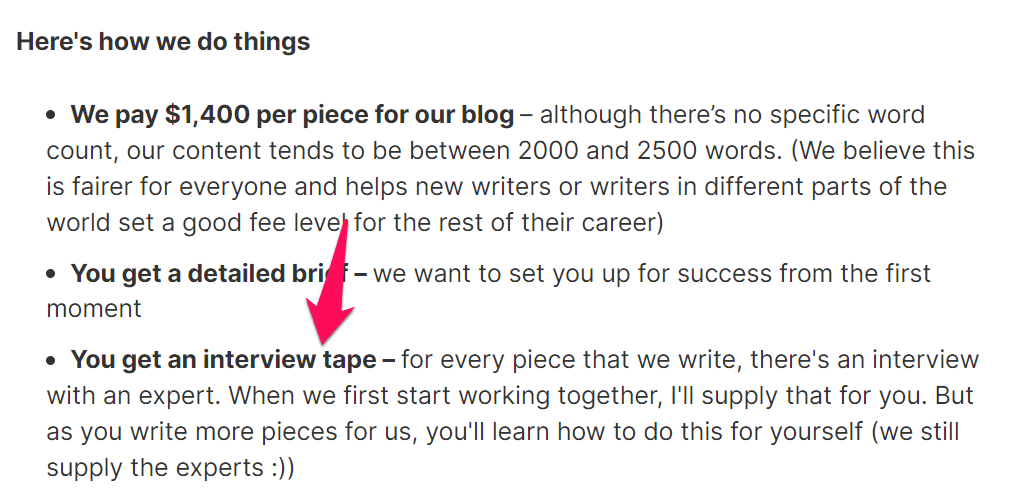
Note that this subject matter expert can be a client, a co-worker (e.g., product lead), or an authority figure in your professional orbit.
Interviewing SMEs is not widely practiced in content marketing, but we’re definitely seeing a steady stream of companies implementing this strategy.
3. Speed up with video (or audio)
Despite its effectiveness, it takes an awfully long time to create a content brief.
And that’s not counting the keyword research process.
If time is of essence or if you’re more of a speaker than a writer, consider recording yourself on video or audio to do a “brain dump” like what Max did here.

That’s right, the post that you’re reading right now was born out of a five-minute video on Loom!
Written, video, or audio, the format of your content brief doesn’t matter. As long as it conveys what you want to be covered, there’s a good chance of your content meeting its desired goal.
Grab your free content brief template today
Content briefs help writers do their best work.
Not only do these editorial documents set the right tone, but they also promote consistency across different writers (no easy feat!) and reduce editing time from your end.

